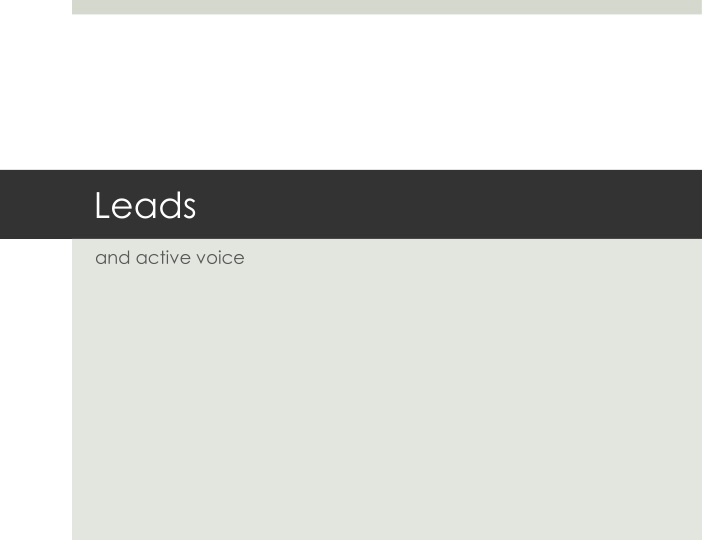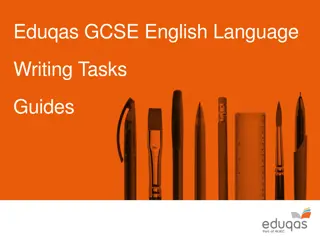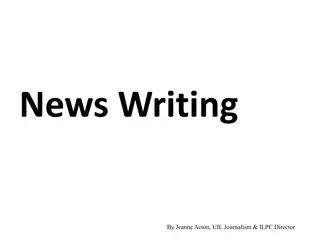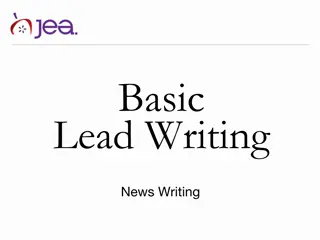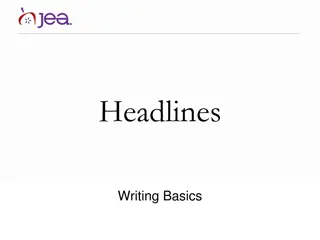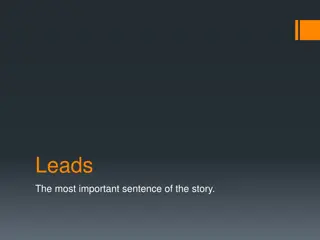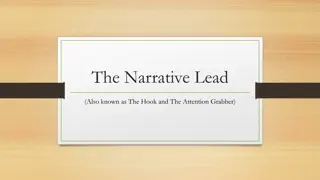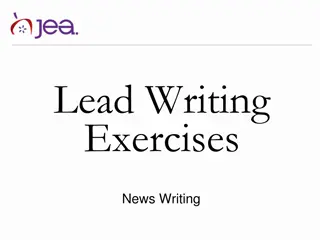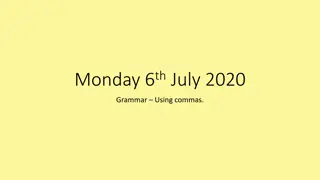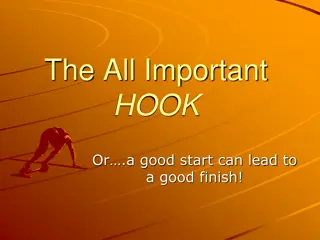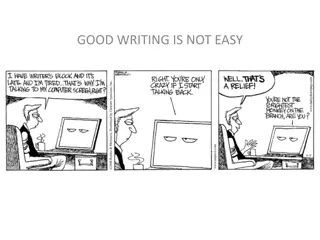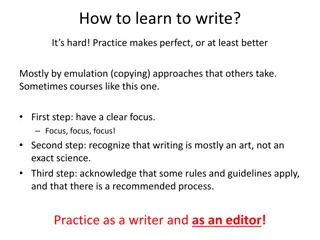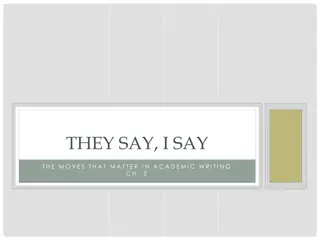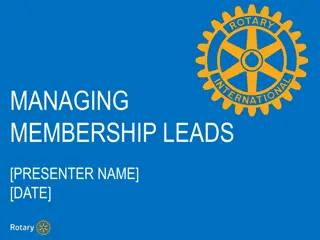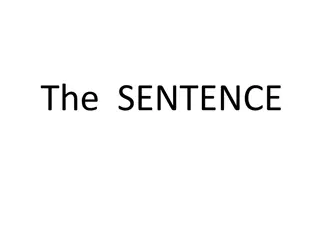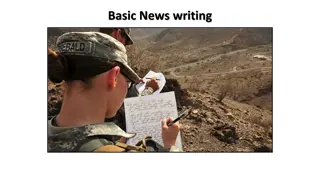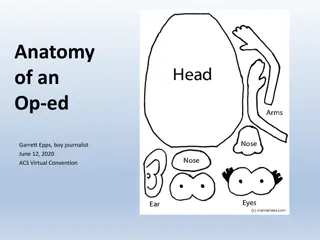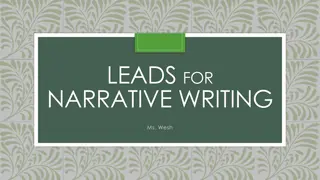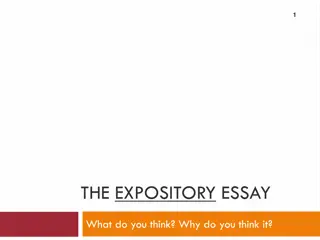Mastering the Art of Writing Engaging Leads and Captivating Readers
Crafting a captivating lead is essential in journalism to entice readers into exploring a story further. This involves using techniques such as compelling photographs, intriguing headlines, and engaging first lines to hook readers from the start. By understanding the importance of strong beginnings and intriguing leads, writers can successfully attract and retain the attention of their audience, as demonstrated through the historical practices of renowned authors and journalists like Herodotus.
Download Presentation

Please find below an Image/Link to download the presentation.
The content on the website is provided AS IS for your information and personal use only. It may not be sold, licensed, or shared on other websites without obtaining consent from the author.If you encounter any issues during the download, it is possible that the publisher has removed the file from their server.
You are allowed to download the files provided on this website for personal or commercial use, subject to the condition that they are used lawfully. All files are the property of their respective owners.
The content on the website is provided AS IS for your information and personal use only. It may not be sold, licensed, or shared on other websites without obtaining consent from the author.
E N D
Presentation Transcript
Leads and active voice
Leads (ledes) The lead is one of four ways journalists use to encourage people to read a story. The others are: Photograph or illustration; Headline (or heading for online material); Deck, subhead or pull quote.
Attracting readers We hope readers will pause at a compelling photo or illustration, and so read an equally compelling headline or heading. From there, we hope they will give the story a try by reading the first line (lead) or first graf (first paragraph, or nut graf. ) Sometimes we add a deck (second headline) or pull quote to further entice.
Reading on If readers are still interested after checking out the lead, they will often read the story. If the lead is boring, they will likely not read the story.
First impressions It is critical, then, to hit hard and start strong at the beginning. Note this is not true for some kinds of writing. Academic writing can be slow because (perhaps) the audience will read the research regardless. Still, it usually can t hurt to try to find a good beginning. I call it snagging and dragging.
Good beginnings Novelists and historians have known throughout written history that they need to snag readers from the beginning. The historian Herodotus in 440 B.C.E. knew he would have to attract readers by showing them right away how important his work was:
Early beginnings These are the researches of Herodotus of Halicarnassus, which he publishes, in the hope of thereby preserving from decay the remembrance of what men have done, and of preventing the great and wonderful actions of the Greeks and the Barbarians from losing their due meed of glory .
Early beginnings Note that Herodotus did not write: The Greeks met several times with the Barbarians a while ago . Novelists also know a good first line will drag their readers in: It was a bright cold day in April, and the clocks were striking thirteen. George Orwell, 1984. Someone must have slandered Josef K., for one morning, without having done anything truly wrong, he was arrested. Franz Kafka, The Trial.
Slow leads People have so much to read nowadays, to say nothing of television, video games, smartphones, etc. Why should they read your story? The answer is usually no reason, unless you make it sound interesting to them. The lead can do that.
SAVE formula To help us write and edit better leads, I suggest considering Ross s SAVE formula, to SAVE your readers from boring leads. A good lead out to be: Specific. Accurate. In active Voice. And use Energetic verbs.
Specific Grand general statements may be okay for term papers and academic articles. For example: Interpersonal skills have been the subject of scholarly study for three decades. This lead is boring, and in the passive voice as well. But academics don t need snagging. They ll read the research regardless (well, maybe).
Specific Mass media editors in journalism, public relations or advertising need to work harder on the beginning. If mass media is about people doing things, often the best lead is to look for something specific that people did!
Specific One common slow lead is based on meeting articles. We often see these leads written as if a secretary was taking minutes: The Burleigh County Commission met Monday at its regular meeting. Agenda issues were discussed. A motion was made to increase property taxes 50 percent. It passed unanimously.
Specific Most editors will recognize that as a buried lead. That is, the most important part of the story is not at the beginning. An editor will bring it to the top: The Burleigh County Commission Monday voted unanimously to raise property taxes 50 percent. Another common example: The CEO of Acme Mills held a press conference today. So what? Be specific: Acme Mills will expand production of its popular candied kale, CEO Irving Nern said today.
Accurate Inaccurate statements are most glaring when part of a headline or lead. They are becoming more common in the world of social media, because for many journalists (or non-journalists) speed trumps accuracy. But at the expense of a media operation s credibility. We are not writing fiction here. If people don t believe you, what s the point?
Voice Mass media editors and writers need to use active voice about three-fourths of the time, I think. Or more. It s livelier, more immediate. It s closer to the way people talk. It emphasizes the verb, the action word. And mass media is about people doing things.
Voice What is active voice? Most people think they know. But don t be too sure about that. Which of the sentences below is in active voice? Collins decided yesterday to fly a kite after work, because he so often told others to go fly a kite. A kite was flown by Collins yesterday after he decided to heed his own words to go fly a kite.
Voice We know the first is in the active voice. In passive voice, the direct object, kite, becomes the subject: He flies a kite. A kite is flown by him. So in active voice, the subject performs the action: Subject, verb, direct object.
Passive voice Passive voice uses a form of the helping verb to be : Coffee is served every morning before work. An optimistic assessment of state spending was offered by the governor. The East Gulch School District website is updated twice a month.
Present/past tense Note that the passive voice has nothing to do with verb tense. You can write in the past tense and still be in the active voice: The Cass County Commission met at its regular meeting Tuesday. Is the above typical lead in active voice? Yep. That doesn t mean it s not boring! But it would be even worse in passive voice: A regular meeting was held Tuesday by the Cass County Commission.
Uses for passive voice We said in media writing we should use active voice at least three-fourths of the time. So what about the other quarter of the time? Passive voice is sometimes useful in three situations: 1. The writer or editor doesn t know who performed the action, or the person performing it isn t as important.
Uses of passive voice Often you ll see passive voice used in crime stories. The victim is more important, and the perpetrator often unknown: The mayor was robbed at gunpoint today in the city hall parking lot. Who did the robbing? Don t know. And the victim was more significant.
Uses of passive voice Accident stories are often in passive voice: Two students were injured Friday in a bicycle crash south of Barry Hall. Who did the injuring? We I guess we could come up with active voice: A cement curb injured two students yesterday . But most editors would prefer passive voice in this case.
Uses of passive voice 2. Need to vary sentence structure. Writers look for variety, and the passive voice can occasionally offer that. It sometimes offers a less awkward way of structuring a sentence, and a way to emphasize a significant word. For example: Miss Brooke had that kind of beauty which seems to be thrown into relief by poor dress. George Eliot, Middlemarch. We could turn the second half into passive voice, but would it be as strong? Probably not.
Uses of passive voice 3. You re not sure of the facts, or want to hide the performer of the action. You can write, in active voice, George Jones hit Sam Smith with his cane. But what if you are not certain George did it? Passive voice gives you a way to avoid assigning blame: Sam Smith was hit with a cane.
Uses of passive voice Academic researchers working as teams often use passive voice because the results are most significant, not the team: An experiment was performed. Results were analyzed. Conclusions were made. Probably readers are more interested in results, so this use of passive voice is reasonable. But not always.
Hiding behind passive voice In business and politics, particularly, it is easy to hide behind passive voice. This gives an opportunity to avoid assigning blame. A decision was made to lay off 100 workers. Who made that decision? We don t know.
Hiding behind passive voice A case study in passive voice can be made from the 1986 Space Shuttle Challenger explosion. Investigators studying documents tried to find blame regarding the manufacturing problems and subsequent decisions among the contractors that led to the disaster. It was impossible to assign responsibility, however, because documents were written in the passive voice: this decision was made, that action was taken, this was done. Through passive voice, company executives could avoid taking blame.
Energetic verbs The fourth letter of our SAVE formula, Energetic verbs, asks us to move beyond tired, overused or bland verbs. Try to avoid forms of the verb to be used as a main verb. Usually it is week and overused: There are good reasons to graduate from college. Swimming is a good way to keep fit. These shoes are mostly brown or black.
Energetic verbs Usually we can find alternatives to the verb to be, and to other common verbs. For example, the verb to walk. It s used over and over. How many alternatives can you think of for this verb? Why not use some of them instead of relying on the same tired verb?
Leads: beyond the SAVE formula We ve already talked about buried leads. The most significant thing is not at the top of the story. We see this often in stories written in a hurry. Writers needs a chance to warm up, and the lead ends up in the second graf.
Buried lead Example: Businesses nowadays need to get bigger to succeed. America has seen quite a few mergers, and has lost quite a few small businesses in recent decades. Reflecting this trend, XYZ company has announced that it will absorb a competitor that has been in Fargo for nearly a century. Note you can delete the entire first paragraph without losing a thing.
Backed-into lead The backed-into lead puts the most significant aspect at the end of the sentence. Example: The chancellor Wednesday said she will authorize a $3.1 million addition to Morrill Hall. What is the news here? Not the chancellor. More than $3 million will go toward remodeling Morrill Hall, the chancellor said Wednesday.
Short leads Try to keep your leads short. Declarative sentences without clauses often work best to attract attention. Journalists often forget that, particularly in political or financial news. Here s a typical example from USA Today (online Sept. 17, 2014) that weighs in at hefty 54 words: The Federal Reserve reassured financial markets Wednesday that a key interest rate will stay near zero for "a considerable time" after its bond purchases end next month, deferring for now a clear signal on how it will begin to shift away from low-rate policies it's had in place since the 2008 financial crisis.
Short leads CNNMoney (online) took a different approach to the same story: Two Words is a track on Kanye West's debut album. It might as well be the theme song for the market and Federal Reserve too. When the #Fed issues its policy statement Wednesday afternoon, the only two words that may matter to Wall Street are considerable time. I do think bringing in Kanye West is a stretch. But the lead certainly is short.
Simple, relatively Of course, you still have to be specific and accurate. And many short sentences and paragraphs sound choppy. Keep things as simple as possible. But not simpler. Albert Einstein.
